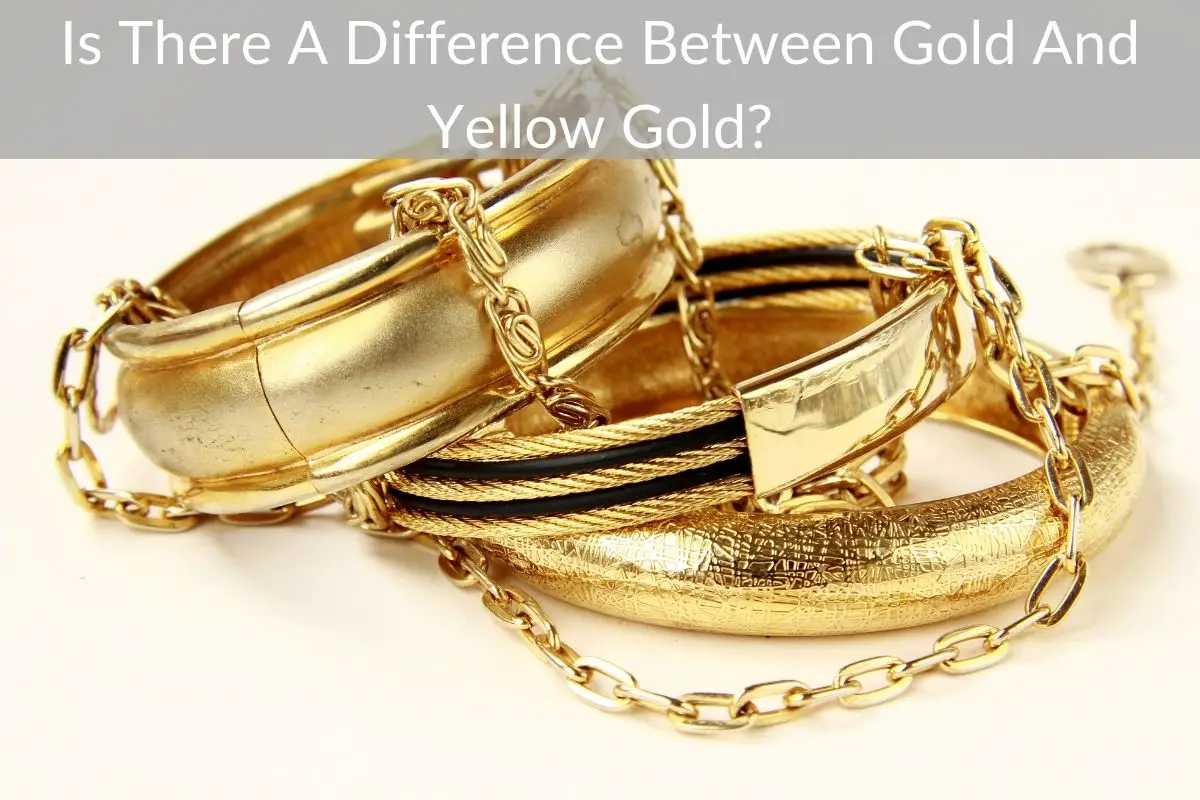Table of Contents
Gold is a beautiful precious metal used to make many types of jewelry. Its shiny and glittering material is not only eye-catching but also valuable.
*This post may contain affiliate links. As an Amazon Associate we earn from qualifying purchases.
You may have heard gold referred to as just gold or yellow gold. So, what is the difference between gold and yellow gold? Is there any difference?
Gold is the same as yellow gold. The yellow coloring in yellow gold is just the color of the gold. Along with yellow gold, there is also white gold and rose gold. Alloy metals added to pure gold make these gold different shades.
So although all yellow gold is gold, not all gold is yellow. Some people will differentiate what type of gold they are talking about by saying yellow gold so there is no confusion.
So, there is no difference between gold and yellow gold. They are the same thing!
Gold comes in three main colors, yellow, white, and rose. The most common of these are yellow gold and white gold. In recent years, white gold has been a popular choice for engagement and wedding bands.
It seems the colors of gold come in and go out of style but white gold has remained extremely popular for the last decade or two.
Gold is mostly worn as these types of jewelry since it is expensive to purchase. Yellow and white gold are valued at the same price. What makes the value of the increase or decrease is their karat weight.
18k,14k, etc. determine how valuable the gold is since that tells how much pure gold is in the jewelry. The color doesn’t have anything to do with what it is worth. It is simply a color preference.
Some people may prefer the yellow or “gold” colored gold while others may prefer a silver/platinum colored white gold. Then some may like a rosy hue to their gold and opt for rose gold.
By blending gold with other metal alloys, you end up with a spectrum of colors as well as plenty of durability. Added metals in 18k gold and lower allows for it to be stronger and less prone to damage since pure gold is soft and fragile.
To see the most popular gold jewelry just click here.
What Are Different Shades Of Gold?
We have been intrigued by gold for centuries. Did you know that gold comes in different colors? While it can actually be found as bright yellow, or even green, all other colors of gold are made possible by the percent of other metals in the jewelry.
When you combine metal, it is referred to as an alloy. This is done by heat and pressure below the earth’s surface or in a crucible.
Alloys are stronger than pure metals. Gold is a pure metal and is very soft so other metals are added to harden it up.
Precious metals like gold are rare making them more expensive so by adding in alloys, you can get a more durable and less expensive piece.
So what are the different shades of gold?
The different shades of gold are yellow, white, rose, green, gray, purple, blue, and black. Yellow, white and rose gold are the most common shades of gold while green, gray, purple, blue, and black gold aren’t as common.
We are going to discuss all of these different shades of gold and how they are made for a better understanding of what makes each one different color.
24k (pure) gold is a bright yellow, but, since it is easily damaged, metal alloys are mixed in when making jewelry. This brings down its worth but also changes its color based on what metal you are adding to the gold.
There are actually several shades that gold can become because of how much or what metal is added to it. Yellow, white and rose are the most common colors of gold while the rest are not as common.
Let’s look at all these different colors of gold and how they differ from each other:
- Yellow Gold
- Is gold’s natural color and the color people think of as “gold”.
- Made by mixing gold with silver, copper, and zinc.
- The metals added to yellow gold allow it to keep its natural color, but make it more strong and durable.
- It is the most hypo-allergenic.
- Requires the least maintenance of all gold colors.
- White Gold
- Is the result of mixing gold with platinum.
- Can also be the result of mixing gold with palladium, nickel, cadmium, and zinc.
- More durable and scratch-resistant than yellow gold.
- More affordable than yellow gold or platinum.
- Rhodium plating is often used to polish it if it has naturally off-white shades.
- Rose Gold
- This gold has copper added to it to get that rosy or pink tint and it also contains silver.
- It is more affordable than other shades of gold because copper is inexpensive.
- Because of the copper, it is more durable than yellow gold or white gold.
- Known as Russian gold because it was popular in Russia in the early 19th century.
- Green Gold
- This gold is a naturally occurring alloy of silver and gold.
- It is a greenish-yellow color and not a straight green.
- The silver gives this shade its color but sometimes copper, or cadmium ( which is added for the green color but is toxic) is added in.
- Gray Gold
- Similar to white gold, this gold is made from gold and palladium.
- Some cheaper potions of this gold don’t contain palladium and instead use silver, manganese, and copper.
- It can also contain iron in the alloy mixture of metals.
- Purple Gold
- Is also known as Amethyst gold and violet gold
- It is an alloy of gold and aluminum
- More brittle than other gold alloys. It can be shattered by a sharp blow
- Because it isn’t durable, this gold is never used by itself in jewelry. But it is covered with a hard layer in conventional jewelry.
- Blue Gold
- Is an exotic gold color made by mixing gold with gallium or indium.
- Can also be created with an alloy of gold, iron, and nickel that is treated to oxidize the iron and create a superficial shade of blue.
- Black Gold
- Rare and the most exotic of golds.
- Can be produced through several methods.
- It is made through patination by applying sulfur-containing and oxygen continuing compounds, or it can be created by controlled oxidation of gold containing chromium or cobalt, etc.
Final Thoughts
Gold is naturally a bright yellow color. Alloys are added to gold to make it stronger and which one and how much of each that are added can change its color.
Yellow, white, and rose gold are the most common. As you can see, there is no difference between gold and yellow gold.



